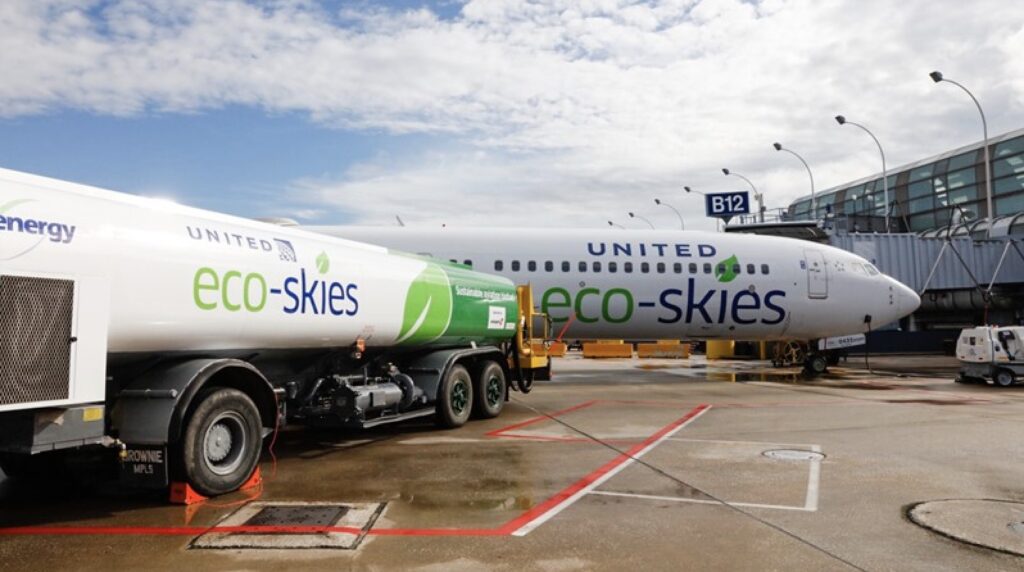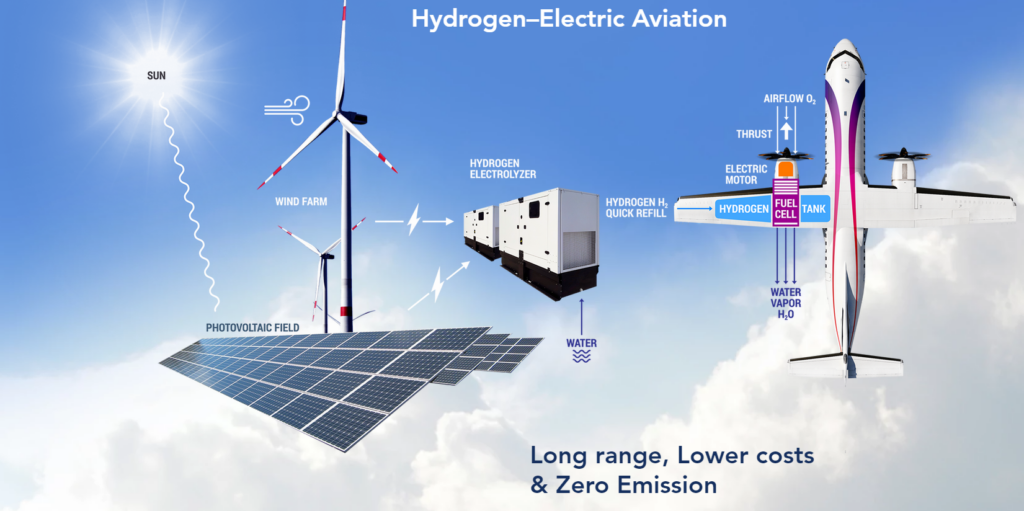By Mark Brooks
Aviation is set to soar in a post-COVID global economy with thousands of new aircraft on order, and a public eager to travel for business and pleasure. Airbus now has over 7,000 orders for new A320 aircraft and more than 600 orders for its fuel-efficient A220, doubling the Airbus fleet worldwide. Boeing has a similar backlog of orders. How can aviation meet its carbon emissions reduction targets while doubling the number of passenger jet aircraft in the skies?
Introducing SAF, Sustainable Aviation Fuel, a drop-in Jet-A replacement that will enable most existing aircraft to reduce carbon emissions by up to 80% today, and up to 100% by 2050. Combined with new airport infrastructure such as Pickering Airport, new more efficient aircraft such as the Airbus 220 (that is pushing 2 litres/ 100 km per passenger), aviation can hit net carbon-zero long before road transportation.

What is the magic elixir of net-zero carbon flight called SAF? Sustainable Aviation Fuel (SAF) is a clean substitute for fossil jet fuels. Rather than being refined from petroleum, SAF is produced from sustainable resources. This is typically waste oils from a biological origin, such as agricultural or forest industry waste and other non-fossil CO2 sources.
SAF is a drop-in fuel, which means that it can be blended with fossil jet fuel and that the blended fuel requires no special infrastructure or equipment changes. Current jet aircraft can run a 50-50 blended mix of SAF and Jet-A, and SAF providers are fully certified (ASTM D1655/ DEFSTAN 91-91) to have the same characteristics and meet the same specifications as fossil jet fuel. Almost a decade ago, in 2012, the National Research Council of Canada conducted a test program that validated the ability of existing jet aircraft to utilize a 100% SAF fuel source with only minor changes.
Since SAF’s first commercial flight operated by KLM in 2011, SAF has gained acceptance and is now a key part of the International Civil Aviation Organization (ICAO) net carbon-zero road map. Aviation currently accounts for approximately 2-3% of man-made global carbon emissions. With timely action, aviation can maintain its rapid growth while reducing its carbon emissions and environmental impact. Over the next decade SAF will be ramping up production and distribution. To date, more than 300,000 flights have been powered in part by SAF.

The aviation industry has committed to carbon-neutral growth from 2020 onward and to net-zero emissions by 2050. With a worldwide carbon footprint and fuel consumption 1/8 that of road transportation, aviation has the potential to beat road transportation to a net zero carbon goal by using sustainable fuels. The road map from ICAO even suggests that an aggressive push to net-zero could be achieved as early as the early 2040s.
The big bottleneck on the horizon is ramping up production fast enough to meet demand. IATA estimates that current SAF production is only 50 million litres annually. To reach a point where the scale of production will see SAF costs drop to levels competitive with jet fuel, production needs to reach seven billion litres (1.85 billion gallons) or two per cent of 2019 consumption according to Alexandre de Juniac, IATA’s Director General and CEO. More on this here:
In contrast, road transportation has no such clear path to net-zero carbon emissions in the same time frame despite existing EV and alternative fuel incentives. The most optimist scenario by BloombergNEF has 58% of new car sales and only 1/3 of all vehicles on the road by 2040 being zero-emission electric vehicles. Even assuming the number of vehicles on the road could be held to under 2 billion worldwide (it is at 1.4 billion today), the gasoline consumption of these vehicles is 8 to 10 times that of aviation making a complete biofuel-based substitution much more challenging. Creating a 100% drop in fuel substitute for today’s gasoline-powered piston car engines is also much more involved compared to the simpler kerosene equivalent used by an aviation turbine or piston diesel engine.
In addition to reducing carbon emissions, SAF has other benefits including:
- Improved airport air quality. Compared to Jet-A, SAF can reduce direct particulate matter (PM) emissions by up to 90% and completely eliminate sulphur (SOX) emissions.
- Improved fuel efficiency. SAF can have a higher energy density than conventional jet fuel resulting in improved fuel efficiency (1.5% – 3%) and more efficient aircraft operations (higher payloads and/or extended range).
- Can be produced locally ensuring a secure supply chain. Local SAF production can increase a region’s energy security and reduced volatility of jet fuel supply and price. It can attract investment, create jobs and economic development.
Over time, aviation will switch to new alternative energy sources (like hydrogen fuel cell and battery electric flight). But existing liquid fuel- powered aircraft will remain an important part of aviation for decades to come. Therefore, sustainable aviation fuel made from renewable feedstock is one of the most important steps towards reducing the aviation industry’s carbon footprint.

SAF is more than just a stopgap measure, it is part of a global industry that will be worth billions of dollars. Both Canada and the United States are in a perfect spot to reap the economic rewards. Unfortunately, misinformation abounds with respect to SAF and its ability to enable existing jet aircraft to become carbon neutral.
Will the new mantra of environmental movement soon be: “If you must travel, please fly” ?
Unfortunately this is highly unlikely, as much of the ”environmental opposition” to aviation, such as staygrounded.org, appears to be rooted in far-left politics. Due to the aviation industry’s pivotal role as the lynchpin of the global capitalist economy, aviation emissions have become heavily politicized and exaggerated by those opposed to global capitalism. Carbon emissions from air travel have been turned into a bogeyman by climate alarmists and clickbait-seeking “news sites” the world over.
What is needed is a clear technical understanding of aviation’s path to a net-zero carbon future as planned by ICAO. In Canada, both federal and provincial governments need to look past the rhetoric and support the production and encourage the use of SAF by the private sector.
Supporting the increased production and consumption of SAF does not require a massive industrial restructuring or hundreds of billions of dollars in public funds. Its adoption can be achieved with simple tax credits, and by the removal of existing jet fuel sales and surcharge taxes on the new fuel.
NACCA (National Airlines Council of Canada) has called on the federal government to immediately take the following actions to encourage SAF:
- Make SAF exempt for the federal carbon tax when blended with aviation fuel. This would place SAF on a level playing field with other renewable fuels and remove the nonsensical road block to aviation decarbonization created by a “carbon tax”. With the carbon tax expected to increase from $30 per ton today to $170 per ton by 2030 this single act would be a huge incentive to switch to SAF.
- Exempting SAF from the federal excise tax on aviation jet fuel (now 4 cents a litre) will also help.
- Provide refundable tax credits accessible to both airlines and aviation fuel suppliers who invest in SAF production or who use SAF.
- Signal the intent to expand Canada’s SAF production capacity through comprehensive, long-term targeted measures that will attract capital investment. This could include the development of a national renewable aviation fuel strategy leveraging Canadas world leading petroleum industry and local sustainable Canadian feedstocks.
SAF offers the potential for immediate and sustained reduction of carbon emissions without the need for investing in new aircraft, new engines, or fast-forwarding costly engine technology maturation programs. This will enable the trillion-dollar fleet of aircraft in the skies today to be a part of a net carbon zero future.
With proper regulation to foster a competitive market, and education to separate political myths from technology reality, SAF can be universally adopted. Combined with new e-Regional aircraft technology, aviation can beat road transportation in achieving a net zero-carbon foot print before 2050.
Reference:
NACC-Pre-budget-submission_SC-Finance_August-2020.pdf (airlinecouncil.ca)
Net-Zero Emissions by 2050 – Canada.ca
Air Canada Commits to Ambitious Net Zero Emissions Goal by 2050 – Mar 15, 2021 (mediaroom.com)
First Practical Zero Emission Aviation Powertrain | USA & UK | ZeroAvia
World’s first 100 percent biofuel-powered flight of civil aircraft (newatlas.com)
United Airlines Operates “Flight For The Planet” – Live and Let’s Fly (liveandletsfly.com)
Sustainable Aviation Fuels Stocktaking (icao.int)
One thought on “Aviation to Beat Road Transportation to Net-zero Carbon Emissions with SAF”
Comments are closed.